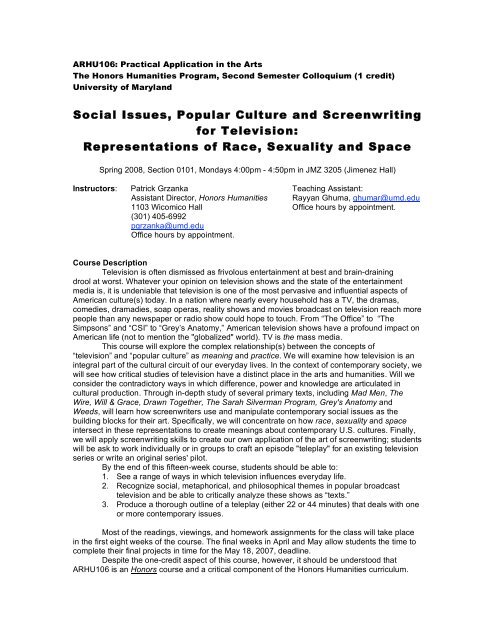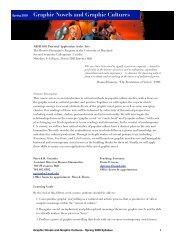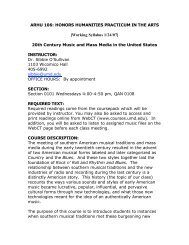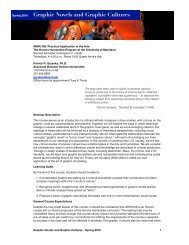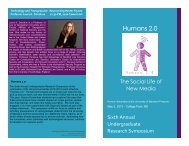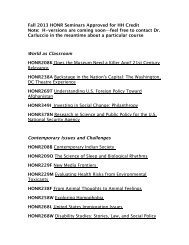Course Syllabus - Writing/Social Issues in Pop Culture (PDF) (2008)
Course Syllabus - Writing/Social Issues in Pop Culture (PDF) (2008)
Course Syllabus - Writing/Social Issues in Pop Culture (PDF) (2008)
Create successful ePaper yourself
Turn your PDF publications into a flip-book with our unique Google optimized e-Paper software.
ARHU106: Practical Application <strong>in</strong> the Arts<br />
The Honors Humanities Program, Second Semester Colloquium (1 credit)<br />
University of Maryland<br />
<strong>Social</strong> <strong>Issues</strong>, <strong>Pop</strong>ular <strong>Culture</strong> and Screenwrit<strong>in</strong>g<br />
for Television:<br />
Representations of Race, Sexuality and Space<br />
Spr<strong>in</strong>g <strong>2008</strong>, Section 0101, Mondays 4:00pm - 4:50pm <strong>in</strong> JMZ 3205 (Jimenez Hall)<br />
Instructors: Patrick Grzanka Teach<strong>in</strong>g Assistant:<br />
Assistant Director, Honors Humanities Rayyan Ghuma, ghumar@umd.edu<br />
1103 Wicomico Hall Office hours by appo<strong>in</strong>tment.<br />
(301) 405-6992<br />
pgrzanka@umd.edu<br />
Office hours by appo<strong>in</strong>tment.<br />
<strong>Course</strong> Description<br />
Television is often dismissed as frivolous enterta<strong>in</strong>ment at best and bra<strong>in</strong>-dra<strong>in</strong><strong>in</strong>g<br />
drool at worst. Whatever your op<strong>in</strong>ion on television shows and the state of the enterta<strong>in</strong>ment<br />
media is, it is undeniable that television is one of the most pervasive and <strong>in</strong>fluential aspects of<br />
American culture(s) today. In a nation where nearly every household has a TV, the dramas,<br />
comedies, dramadies, soap operas, reality shows and movies broadcast on television reach more<br />
people than any newspaper or radio show could hope to touch. From “The Office” to “The<br />
Simpsons” and “CSI” to “Grey’s Anatomy,” American television shows have a profound impact on<br />
American life (not to mention the "globalized" world). TV is the mass media.<br />
This course will explore the complex relationship(s) between the concepts of<br />
“television” and “popular culture” as mean<strong>in</strong>g and practice. We will exam<strong>in</strong>e how television is an<br />
<strong>in</strong>tegral part of the cultural circuit of our everyday lives. In the context of contemporary society, we<br />
will see how critical studies of television have a dist<strong>in</strong>ct place <strong>in</strong> the arts and humanities. Will we<br />
consider the contradictory ways <strong>in</strong> which difference, power and knowledge are articulated <strong>in</strong><br />
cultural production. Through <strong>in</strong>-depth study of several primary texts, <strong>in</strong>clud<strong>in</strong>g Mad Men, The<br />
Wire, Will & Grace, Drawn Together, The Sarah Silverman Program, Grey's Anatomy and<br />
Weeds, will learn how screenwriters use and manipulate contemporary social issues as the<br />
build<strong>in</strong>g blocks for their art. Specifically, we will concentrate on how race, sexuality and space<br />
<strong>in</strong>tersect <strong>in</strong> these representations to create mean<strong>in</strong>gs about contemporary U.S. cultures. F<strong>in</strong>ally,<br />
we will apply screenwrit<strong>in</strong>g skills to create our own application of the art of screenwrit<strong>in</strong>g; students<br />
will be ask to work <strong>in</strong>dividually or <strong>in</strong> groups to craft an episode "teleplay" for an exist<strong>in</strong>g television<br />
series or write an orig<strong>in</strong>al series' pilot.<br />
By the end of this fifteen-week course, students should be able to:<br />
1. See a range of ways <strong>in</strong> which television <strong>in</strong>fluences everyday life.<br />
2. Recognize social, metaphorical, and philosophical themes <strong>in</strong> popular broadcast<br />
television and be able to critically analyze these shows as “texts.”<br />
3. Produce a thorough outl<strong>in</strong>e of a teleplay (either 22 or 44 m<strong>in</strong>utes) that deals with one<br />
or more contemporary issues.<br />
Most of the read<strong>in</strong>gs, view<strong>in</strong>gs, and homework assignments for the class will take place<br />
<strong>in</strong> the first eight weeks of the course. The f<strong>in</strong>al weeks <strong>in</strong> April and May allow students the time to<br />
complete their f<strong>in</strong>al projects <strong>in</strong> time for the May 18, 2007, deadl<strong>in</strong>e.<br />
Despite the one-credit aspect of this course, however, it should be understood that<br />
ARHU106 is an Honors course and a critical component of the Honors Humanities curriculum.
1/28/08<br />
The read<strong>in</strong>g and writ<strong>in</strong>g load may be considered heavy, though this course strictly follows the<br />
college-level standard of three hours of outside work per credit hour. Commitment to fulfill<strong>in</strong>g the<br />
requirements of the course is essential to success <strong>in</strong> the class and will be reflected <strong>in</strong> students’<br />
f<strong>in</strong>al grades. It should also be noted that many of the ideas presented <strong>in</strong> this course will be built<br />
upon <strong>in</strong> ARHU205: Modes of Know<strong>in</strong>g and Do<strong>in</strong>g <strong>in</strong> the Arts and Humanities.<br />
No previous knowledge of any series <strong>in</strong> the course is required (or even preferred.) Every<br />
student, regardless of her familiarity with these series, will have an equal opportunity to succeed<br />
<strong>in</strong> the course.<br />
Patrick Grzanka will be your primary <strong>in</strong>structor for this course, though your Honors<br />
Humanities Keystone Project progress may be evaluated by Dr. Peter Mallios, Just<strong>in</strong> Maher or<br />
Sarah Hamilton (depend<strong>in</strong>g on who you have been work<strong>in</strong>g with up to this po<strong>in</strong>t). Honors<br />
Humanities alumna Rayyan Ghuma will serve as the teach<strong>in</strong>g assistant.<br />
Evaluation<br />
Grad<strong>in</strong>g for the course is as follows:<br />
20%: Class participation. While attendance is not mandatory, thoughtful participation <strong>in</strong><br />
class is a crucial part of succeed<strong>in</strong>g <strong>in</strong> the course. The <strong>in</strong>structor will lead discussions,<br />
but it is each student’s responsibility to actively participate <strong>in</strong> class. Because summaries<br />
of the read<strong>in</strong>gs are not required every week, <strong>in</strong>-class participation is the only way for the<br />
<strong>in</strong>structor to know whether a student is do<strong>in</strong>g the required read<strong>in</strong>g. In-class participation<br />
is not limited to speak<strong>in</strong>g <strong>in</strong> class -- short, written quizzes on the assigned material will be<br />
given throughout the semester.<br />
5%: Assignments. All written assignments, not <strong>in</strong>clud<strong>in</strong>g your analytic essay or f<strong>in</strong>al<br />
project, are due <strong>in</strong> hard copy form at the start of class for which they are due. Late<br />
assignments will not be accepted.<br />
20%: Analytic essay. Dur<strong>in</strong>g the semester, you will develop a 4-7 page essay analyz<strong>in</strong>g<br />
one or more of television series us<strong>in</strong>g the analytical tools and frameworks we learn <strong>in</strong><br />
class. This essay will be due toward the end of the semester, but you will work on it<br />
throughout the course.<br />
35%: F<strong>in</strong>al project. This course is about practical applications <strong>in</strong> the arts. Thus, the<br />
practical application – development of a teleplay – is the most important part of this<br />
course. Students may work <strong>in</strong>dividually or <strong>in</strong> groups (of up to 4 people) for the f<strong>in</strong>al<br />
project. More details will be provided dur<strong>in</strong>g the first half of the course.<br />
20%: Annotated bibliography for the Honors Humanities Keystone Project. All<br />
HonHum students are required to ma<strong>in</strong>ta<strong>in</strong> satisfactory progress towards completion of<br />
their Keystone Project throughout ARHU106. By the end of the semester students will<br />
have expanded and annotated their bibliography to 20 sources.<br />
The grad<strong>in</strong>g will be on a traditional scale of 90-100=A, 80-89=B, 70-79=C, etc.<br />
Required Texts:<br />
Gilles, D. B. (2000). The Screenwriter With<strong>in</strong>. NY: Three Rivers Press.<br />
<strong>Course</strong> read<strong>in</strong>gs, available via Blackboard (www.elms.umd.edu)<br />
View<strong>in</strong>g Nights:<br />
Several times dur<strong>in</strong>g the semester, students will have the option of screen<strong>in</strong>g the<br />
required episodes as a group. View<strong>in</strong>g nights are typically held immediately after regularly<br />
scheduled class meet<strong>in</strong>gs. For people who cannot attend the group view<strong>in</strong>g nights, the required<br />
episodes will be available for short-term loan from the Honors Humanities lounge <strong>in</strong> Wicomico<br />
Hall. It is important to remember that all of the episodes listed on the syllabus are required<br />
assignments, and each student is responsible for see<strong>in</strong>g the episodes – with the group or on an<br />
<strong>in</strong>dividual basis -- on time for the class <strong>in</strong> which they will be discussed.<br />
Keystone Project Annotated Bibliography:
1/28/08<br />
Students are required to ma<strong>in</strong>ta<strong>in</strong> satisfactory progress towards completion of their<br />
keystone project dur<strong>in</strong>g the spr<strong>in</strong>g semester <strong>in</strong> ARHU106. This semester you will read the<br />
sources you identified <strong>in</strong> your bibliography dur<strong>in</strong>g the fall semester, you will expand your<br />
bibliography from ten to at least 20 sources, and you will annotate all of your sources <strong>in</strong> the MLA<br />
style. Guidel<strong>in</strong>es for annotation are available on the ELMS/Blackboard page. To access your<br />
Blackboard space, go to http://www.elms.umd.edu.<br />
F<strong>in</strong>al Project – An Orig<strong>in</strong>al Teleplay<br />
For the course’s f<strong>in</strong>al project, students may work <strong>in</strong>dividually or <strong>in</strong> groups of up to four<br />
members to create an orig<strong>in</strong>al teleplay. The teleplay may be a completely orig<strong>in</strong>al concept, or be<br />
a new episode of an exist<strong>in</strong>g television series (a “spec script”). The plot of the outl<strong>in</strong>e must deal<br />
with one or more contemporary social issues. The teleplay script must have a length of<br />
approximately 22 or 44 m<strong>in</strong>utes, the length of the average TV sitcom or drama. The<br />
extensiveness of the project will depend on the length format chosen by the student and group<br />
size. For example, if work<strong>in</strong>g alone, the student will be expected – regardless of teleplay length –<br />
to submit a complete plot outl<strong>in</strong>e with at least one scene of dialogue. If four students work<br />
together, they must submit a thorough outl<strong>in</strong>e of a complete 22- or 44-m<strong>in</strong>ute script with at least<br />
six scenes of dialogue.<br />
More details about the appropriate formatt<strong>in</strong>g for the teleplay and length requirements will<br />
be provided later <strong>in</strong> the course. Students may also have access to examples of these projects<br />
created by Honors Humanities students who participated <strong>in</strong> previous versions of this course.<br />
Extra Credit<br />
There is one extra credit opportunity built <strong>in</strong>to the course, though other may become<br />
available throughout the semester (most likely <strong>in</strong>clud<strong>in</strong>g attendance at Honors Humanities<br />
popsmARTs events).<br />
To receive 100 percent on two quiz grades, students may read and annotate (1-2 pages)<br />
a scholarly article or book chapter deal<strong>in</strong>g with race, sexuality and/or space <strong>in</strong> contemporary<br />
U.S. popular culture (not limited strictly to television). The recommended article (available on<br />
Blackboard) is: Lee, R. C. (2004). ‘Where’s my parade?’: Margaret Cho and the Asian American<br />
body <strong>in</strong> space. The Drama Review, 48, 108-132. The <strong>in</strong>structor must approve other scholarly<br />
articles <strong>in</strong> advance.<br />
Documented Disabilities<br />
Students who have documented disabilities and who wish to discuss academic<br />
accommodations with<strong>in</strong> this course should contact the <strong>in</strong>structor as soon as possible after the<br />
beg<strong>in</strong>n<strong>in</strong>g of the course.<br />
Incompletes<br />
In this course, the mark of "I" will be granted only to a student who meets both of the<br />
follow<strong>in</strong>g criteria: (1) the student has satisfactorily completed a major portion of the work of the<br />
course and (2) the student has been unable to complete some small portion of the work of the<br />
course because of illness or other circumstances beyond the student's control. Examples of<br />
reasons for the <strong>in</strong>ability to complete course work that will not qualify a student for an "I" mark<br />
<strong>in</strong>clude the follow<strong>in</strong>g: employment or volunteer commitments, social responsibilities, travel plans,<br />
and unexpected difficulties <strong>in</strong> satisfy<strong>in</strong>g course requirements.<br />
Academic Integrity<br />
The University of Maryland, College Park has a nationally recognized Code of Academic<br />
Integrity, adm<strong>in</strong>istered by the Student Honor Council. This Code sets standards for academic<br />
<strong>in</strong>tegrity at Maryland for all undergraduate and graduate students. As a student you are<br />
responsible for uphold<strong>in</strong>g these standards for this course. It is very important for you to be aware<br />
of the consequences of cheat<strong>in</strong>g, fabrication, facilitation, and plagiarism. For more <strong>in</strong>formation on<br />
the Code of Academic Integrity or the Student Honor Council, please visit<br />
http://www.studenthonorcouncil.umd.edu/whatis.html
1/28/08<br />
Assignments and <strong>Course</strong> Schedule<br />
*All assignments, <strong>in</strong>clud<strong>in</strong>g read<strong>in</strong>gs, will be due the week they are listed unless otherwise<br />
noted.*<br />
Week One (1/28/08) – <strong>Pop</strong> Matters<br />
! Television and the Arts and Humanities, <strong>in</strong>troduction to the course and current issues <strong>in</strong><br />
contemporary television; key themes/terms.<br />
Week Two (2/4) – Representation & The Circuit of <strong>Culture</strong><br />
! What is representation? How do we decode mean<strong>in</strong>gs <strong>in</strong> television?<br />
! Assignment: What is your favorite TV show and why?<br />
! Read:<br />
o<br />
o<br />
Hall, S. (1997). Introduction. In S. Hall (Ed.), Representation: Cultural<br />
representations and signify<strong>in</strong>g practices (pp. 1-13). London: Sage Publications &<br />
Open University.<br />
Kellner, D. (2003). Critical Perspectives on Television from the Frankfurt School<br />
to Postmodernism. From Kellner’s Homepage:<br />
http://www.gseis.ucla.edu/faculty/kellner/flash/ Go to “Essays.” Also available on<br />
Blackboard.<br />
Week Three (2/11) – Race as Representation<br />
! Read:<br />
o Hunt, D. M. (2005). Mak<strong>in</strong>g sense of blackness on television. In D. M. Hunt (Ed.),<br />
Channel<strong>in</strong>g blackness: Studies on television and race <strong>in</strong> America (pp. 1-24). New<br />
York: Oxford University Press.<br />
o Gray, H. S. (2005). Different dreams, dreams of difference. In Cultural moves:<br />
African Americans and the politics of representation (pp. 114-119). Berkeley:<br />
University of California Press.<br />
Week Four (2/18) – Sexualities and/<strong>in</strong> <strong>Pop</strong>ular <strong>Culture</strong><br />
! Read:<br />
! Zeman, N. (2003). Gay-per-view TV; With Will & Grace, Queer Eye for the<br />
Straight Guy, and Boy Meets Boy, prime time has come out. Vanity Fair.<br />
! Tropiano, S. (2003). The prime time closet: Into the ma<strong>in</strong>stream.<br />
<strong>Pop</strong>matters.com.<br />
! Warn, S. (2003). Vanity Fair the latest to use gay men as lesbian equivalent.<br />
AfterEllen.com.<br />
Week Five (2/25) – (One) Queer Space: Will & Grace<br />
! Read:<br />
o<br />
Mitchell, D. (2005). Produc<strong>in</strong>g conta<strong>in</strong>ment: The rhetorical construction of<br />
difference <strong>in</strong> Will & Grace. Journal of <strong>Pop</strong>ular <strong>Culture</strong>, 38, 1050-1069.<br />
o Nero, C. I. (2005). Why are gay ghettos white? In E. P. Johnson & M. G.<br />
Henderson (Eds.), Black Queer Studies: An Anthology (pp. 228-247). Durham:<br />
Duke University Press.<br />
o<br />
Watch:<br />
! Season Six, Episode Seventeen, “East Side Story”<br />
Week Six (3/3) – Construct<strong>in</strong>g the Past: Mad Men<br />
! Read:<br />
o Stanley, A. (2007). Smok<strong>in</strong>g, dr<strong>in</strong>k<strong>in</strong>g, cheat<strong>in</strong>g and sell<strong>in</strong>g. New York Times, 19<br />
July.<br />
o Mittell, J. (2006). Narrative complexity <strong>in</strong> contemporary American television. The<br />
Velvet Light Trap, 58, 29-40.
1/28/08<br />
! Watch:<br />
o<br />
Season One, Episode One: “Smoke Gets <strong>in</strong> Your Eyes”<br />
Week Seven (3/10) – Race and Sex <strong>in</strong> Suburban Space: Weeds<br />
! Plus: Discussion of basic screenwrit<strong>in</strong>g techniques; <strong>in</strong>troduction to the f<strong>in</strong>al project.<br />
! Read:<br />
o<br />
o<br />
! Watch:<br />
o<br />
Introduction and first 6 chapters of The Screenwriter With<strong>in</strong> by D.B. Giles.<br />
Sies, M. C. (2005). Theoriz<strong>in</strong>g class, race, gender, and place. Research<br />
Connections, Spr<strong>in</strong>g, 12-14. College Park, MD: Consortium on Race, Gender<br />
and Ethnicity.<br />
Season One, Episodes One and Four: “You Can’t Miss the Bear” and “Fashion of<br />
the Christ”<br />
Week Eight (3/17) – Spr<strong>in</strong>g Break, no class.<br />
Week N<strong>in</strong>e (3/24) – Race and Sex <strong>in</strong> Urban Space: The Wire<br />
! Assignment: Analytic Essay proposal (
1/28/08<br />
Week Fifteen (5/5) – Script Read<strong>in</strong>g/Edit<strong>in</strong>g<br />
! Assignment: Prepare rough draft of teleplay for read<strong>in</strong>g <strong>in</strong> class.<br />
Week Sixteen (5/12) – Conclusions<br />
Exam Week<br />
! Turn <strong>in</strong> analytic essay to the Honors Humanities office <strong>in</strong> Wicomico Hall by 5:00 p.m. on<br />
May 14 th .<br />
! Turn <strong>in</strong> f<strong>in</strong>al project to the Honors Humanities office <strong>in</strong> Wicomico Hall by 5:00 p.m. on<br />
May 21 st .<br />
! Turn <strong>in</strong> annotated bibliography for Honors Humanities Keystone Project by 5:00 p.m.<br />
on May 21 st .


